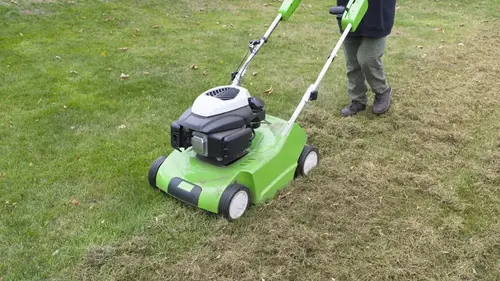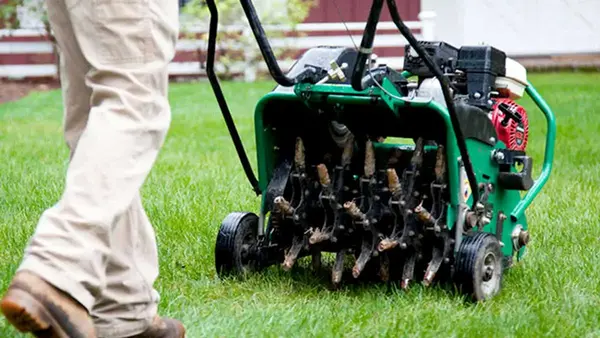Prepping Your Lawn for Aeration: Steps to Ensure a Lush Green Carpet
Your lawn, with its lush, green expanse, is like nature’s carpet, inviting you to step into a world of beauty and tranquility. But to keep it looking its best, it occasionally needs a little care and attention. Aeration is one such crucial maintenance task. It’s the equivalent of fluffing the fibers of your carpet, allowing your grass to breathe and thrive. So, before you fire up that aerator, here’s your guide on what to do to prepare your lawn for this essential treatment.
Why Aeration Matters
Before we dive into the pre-aeration checklist, let’s quickly touch on why aeration is vital:
- Improved Oxygen Flow: Aeration helps air, water, and nutrients reach the grassroots. It’s like providing your lawn with a breath of fresh air.
- Reduced Soil Compaction: Over time, soil compacts, restricting root growth and water infiltration. Aeration loosens the soil, promoting healthy root development.
- Thatch Control: Thatch, a layer of dead grass and debris, can suffocate your lawn. Aeration breaks up thatch, preventing it from becoming a barrier.
- Enhanced Fertilizer Uptake: After aeration, your lawn is more receptive to fertilizers, ensuring they reach the roots effectively.
Now, let’s get down to the nitty-gritty of preparing your lawn for aeration.
What To Do Before Aerating Lawn
1. Water Your Lawn
When to Do It: About a day or two before aeration, give your lawn a deep watering. This ensures that the soil is adequately moist but not waterlogged.
Why It’s Important: Aeration is more effective when the soil is slightly damp. It allows the aerator’s tines to penetrate the ground easily, breaking up compacted soil.
2. Mark Utilities
When to Do It: Before the aeration day, mark all underground utilities, sprinkler systems, and any other potential hazards in your lawn.
Why It’s Important: Avoiding these areas during aeration prevents damage to your utilities and keeps you safe.
3. Cut the Grass
When to Do It: Mow your lawn a day or two before aeration.
Why It’s Important: Aeration is most effective when performed on shorter grass. It allows the aerator to reach the soil without interference.
4. Remove Debris
When to Do It: Clear your lawn of any debris, such as branches, toys, or stones, before aeration.
Why It’s Important: Debris can obstruct the aerator’s path and affect the quality of aeration.
5. Know Your Lawn Type
When to Do It: Identify your grass type and understand its unique needs. This knowledge guides your aeration process.
Why It’s Important: Different grasses have varying preferences and tolerances, so knowing your lawn type is essential for optimal care.
6. Aerator Choice
When to do it: Decide whether you’ll use a spike aerator or a plug aerator, and rent or purchase one accordingly.
Why It’s Important: The choice of aerator impacts the effectiveness of aeration. Spike aerators create holes without removing cores, while plug aerators pull out plugs of soil, offering more substantial benefits.

How Aeration Works
Aeration is like a spa day for your lawn. It involves perforating the soil with holes, either by using spikes or removing soil cores. These holes serve several crucial purposes:
- Allow air, water, and nutrients to penetrate the root zone.
- Encourage root growth by reducing soil compaction.
- Break up thatch and help it decompose.
The Aeration Adventure: What Happens Next?
Now that your lawn is prepped and primed for aeration, let’s dive into what happens during and after the aeration process. It’s time for your lawn to breathe freely, grow stronger, and become the green oasis you’ve always dreamed of.
Aeration in Action
Aeration day is a bit like a spa day for your lawn. Here’s what you can expect:
- The Aerator’s Arrival: Whether you’re using a spike aerator or a plug aerator, it will be brought to your lawn.
- Start Aeration: The aerator is pushed or towed across your lawn. If you’re using a plug aerator, it will pull out small soil cores. If it’s a spike aerator, it will create holes in the soil.
- Hole Placement: The holes or soil cores are strategically placed, typically spaced a few inches apart.
- Breathe Easy: Your lawn is now ready to breathe, as air, water, and nutrients can easily penetrate the root zone.
- Thatch Breakup: The aeration process also helps break up thatch, ensuring it doesn’t suffocate your lawn.
After Aeration: TLC for Your Lawn
Aeration isn’t a one-and-done deal; there are essential post-aeration steps to follow:
- Leave the Cores: If you’ve used a plug aerator, leave the soil cores on your lawn. They will break down and help enrich the soil.
- Fertilize: Consider fertilizing your lawn after aeration. It’s more effective now, as the nutrients can reach the roots more easily.
- Watering: Give your lawn a gentle, deep watering after aeration. This helps the soil cores break down and ensures that air and nutrients can penetrate the soil.
- Seed and Topdress: If your lawn needs overseeding or topdressing, post-aeration is an excellent time to do it. The holes or gaps created by aeration provide a perfect opportunity for new seeds to establish themselves.
- Regular Care: Continue with your regular lawn care routine, including mowing and watering as needed. Your lawn will now respond even better to the care you provide.
The Timeless Art of Lawn Aeration
Aeration is more than a lawn care task; it’s a form of artistry. It’s about rejuvenating your lawn, allowing it to breathe, and giving it the opportunity to become the lush, verdant carpet you’ve always envisioned. It’s a celebration of nature, an oasis of green tranquility.
So, as your lawn undergoes this transformation, sit back and appreciate the beauty of the process. Your lawn is on its way to becoming a masterpiece of natural wonder.
How To Kill Winter Weeds In Lawn
FAQs: Preparing Your Lawn for Aeration
Why is aeration necessary for my lawn?
Aeration is essential for several reasons: it reduces soil compaction, improves oxygen flow to the roots, breaks up thatch, and enhances fertilizer uptake. These benefits lead to a healthier and more vibrant lawn.
When is the best time to aerate my lawn?
The best time for aeration depends on your grass type and climate. For cool-season grasses, early spring or fall is ideal. Warm-season grasses should be aerated in late spring or early summer.
Is it necessary to water the lawn before aeration?
Yes, it’s recommended to water your lawn a day or two before aeration. Slightly moist soil allows the aerator to penetrate effectively, breaking up compacted soil.
What’s the significance of marking utilities before aeration?
Marking underground utilities and potential hazards is essential to avoid damaging them during aeration. It ensures safety and prevents costly repairs.
How short should I mow my lawn before aeration?
Mow your lawn to a shorter height a day or two before aeration. This allows the aerator’s tines to reach the soil without interference.
Do I need to remove the soil cores after aeration?
If you’ve used a plug aerator, it’s best to leave the soil cores on the lawn. They will break down and enrich the soil. If you’ve used a spike aerator, there are no cores to remove.
Can I overseed my lawn immediately after aeration?
Yes, post-aeration is an excellent time to overseed. The holes created by aeration provide an ideal environment for new seeds to establish themselves.
Should I fertilize my lawn after aeration?
Consider fertilizing your lawn after aeration. The improved access to the root zone ensures that nutrients are absorbed more effectively.
Can I aerate my lawn on my own, or should I hire a professional?
You can aerate your lawn on your own with the right equipment, but it’s essential to follow the pre-aeration steps and instructions carefully. If you’re unsure or have a large lawn, hiring a professional may be a good choice.
Is there a specific type of aerator I should use for my lawn?
The choice between a spike aerator and a plug aerator depends on your lawn’s needs. Plug aerators are typically more effective as they remove soil cores, offering significant benefits. The choice depends on your lawn’s condition and requirements.
Preparation before aeration is vital to ensuring the process is effective and beneficial for your lawn. Understanding the specific needs of your grass type, following the pre-aeration checklist, and taking the necessary post-aeration steps will help you achieve a vibrant and healthy lawn.
What grass types benefit the most from aeration?
Aeration is beneficial for various grass types, but it’s especially valuable for cool-season grasses like Kentucky bluegrass, fescue, and ryegrass. Warm-season grasses can also benefit, but the timing and frequency may differ.
Can I aerate my lawn more than once a year?
In most cases, it’s not necessary to aerate more than once a year. Over-aerating can potentially stress your lawn. However, if your soil is exceptionally compacted, you may consider aerating twice a year.
How deep should the aeration holes or soil cores be?
The holes or soil cores created by aeration should typically be 2–3 inches deep. This depth allows for proper air and water penetration into the root zone.
Can aeration help with lawn moss problems?
Aeration can aid in reducing moss problems by improving the soil’s health. It enhances drainage, reduces thatch, and encourages grass growth, all of which can help reduce moss infestations.
What are the signs that my lawn needs aeration?
If your lawn experiences frequent water runoff, soil compaction, or struggles to absorb water and nutrients, it may be time for aeration. Additionally, if your grass has a spongy feel or if you notice a thatch layer, aeration can be beneficial.
Are there any environmental concerns with aeration?
Aeration is generally safe for the environment. If you’re concerned about soil cores left on the lawn, keep in mind that they will break down naturally and enrich the soil.
Can I aerate in the middle of summer?
Aerating in the heat of summer is generally not recommended, as it can stress your lawn further. It’s better to aerate during the cooler seasons for the best results.
What type of equipment do I need for aeration?
You can rent or purchase spike or plug aerators. The choice of equipment depends on your lawn’s specific needs and your preference.
Can I walk on my lawn immediately after aeration?
It’s best to avoid heavy foot traffic on the lawn immediately after aeration to allow the grass and soil to recover. Stay off the lawn for a day or two.
Does aeration improve drought resistance?
Yes, aeration can enhance your lawn’s drought resistance by allowing deeper root growth and better access to water and nutrients.
Pre-aeration preparation is just the beginning of your journey to a healthier, more vibrant lawn. Aeration can make a significant difference in the health and appearance of your grass. By understanding the process and following the pre- and post-aeration steps, you’ll set your lawn on a path to lush green success.
Conclusion
It’s clear that aeration is more than just a lawn care task; it’s a pathway to a greener, healthier haven right outside your door. By following the pre-aeration steps that is what to do before aerating lawn, you’ve laid the groundwork for your lawn’s transformation.
From careful watering to understanding your grass type and making the right equipment choices, these preparations are the keys to aeration success. A well-hydrated lawn, shorter grass, and knowledge of your grass type set the stage for the aeration process, ensuring that your lawn breathes easily and grows strong.
Aeration is not just about poking holes in your lawn; it’s about creating the ideal environment for your grass to thrive. It’s about fostering a green oasis where nature’s beauty can flourish. So, as your lawn embarks on its journey of rejuvenation, take a moment to appreciate the role you play in nurturing its health and vitality.

